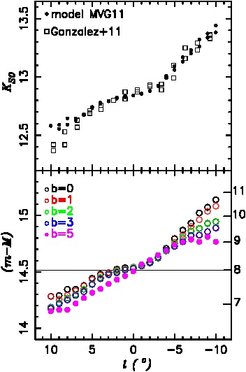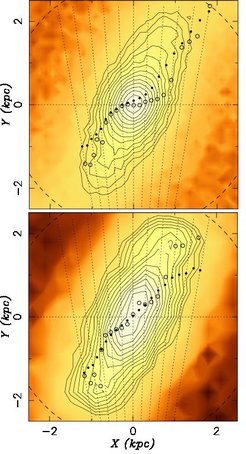The inner Galactic bulge: evidence for a nuclear bar?
Ortwin Gerhard & Inma Martinez-Valpuesta, 2012, ApJL, 744, 8 (to the paper)
Starcount observations show evidence for a structural change in the Milky Way bulge inward of
|l|~4◦. With an N-body barred galaxy simulation we showed that a boxy bulge formed through the bar and buckling instabilities matches these observations. The change in the slope of the model longitude profiles is caused by a transition from highly elongated to more nearly axisymmetric isodensity contours in the inner boxy bulge. This transition is confined to a few degrees from the Galactic plane.The same simulation snapshot was earlier used to clarify the apparent boxy bulge—long bar dichotomy. Furthermore, the nuclear star count map derived from this simulation snapshot displays a longitudinal asymmetry similar to that observed in the TwoMicron All Sky Survey (2MASS) data. These combined results
- support the interpretation that the Galactic bulge originated from disk evolution,
- and question arguments based on star count data for the existence of a secondary nuclear bar in the Milky Way.

Maxima of observed and modeled magnitude distributions for red clump (RC) giant stars in bulge fields as a function of longitude. Top: Simulated (black dots), compared with data from the VVV survey at b = ±1◦ (Gonzalez et al. 2011, A&A, 534, 14; open squares).

Face-on surface density of the particles with |z| smaller then 300 pc (top) and at b between 3 and 4, with overplotted maxima of the line-of-sight density distributions (open circles) and maxima of the simulated line-of-sight RC magnitude distributions (full circles)

